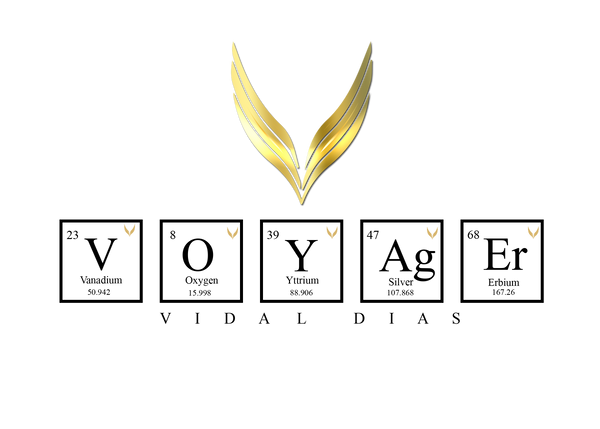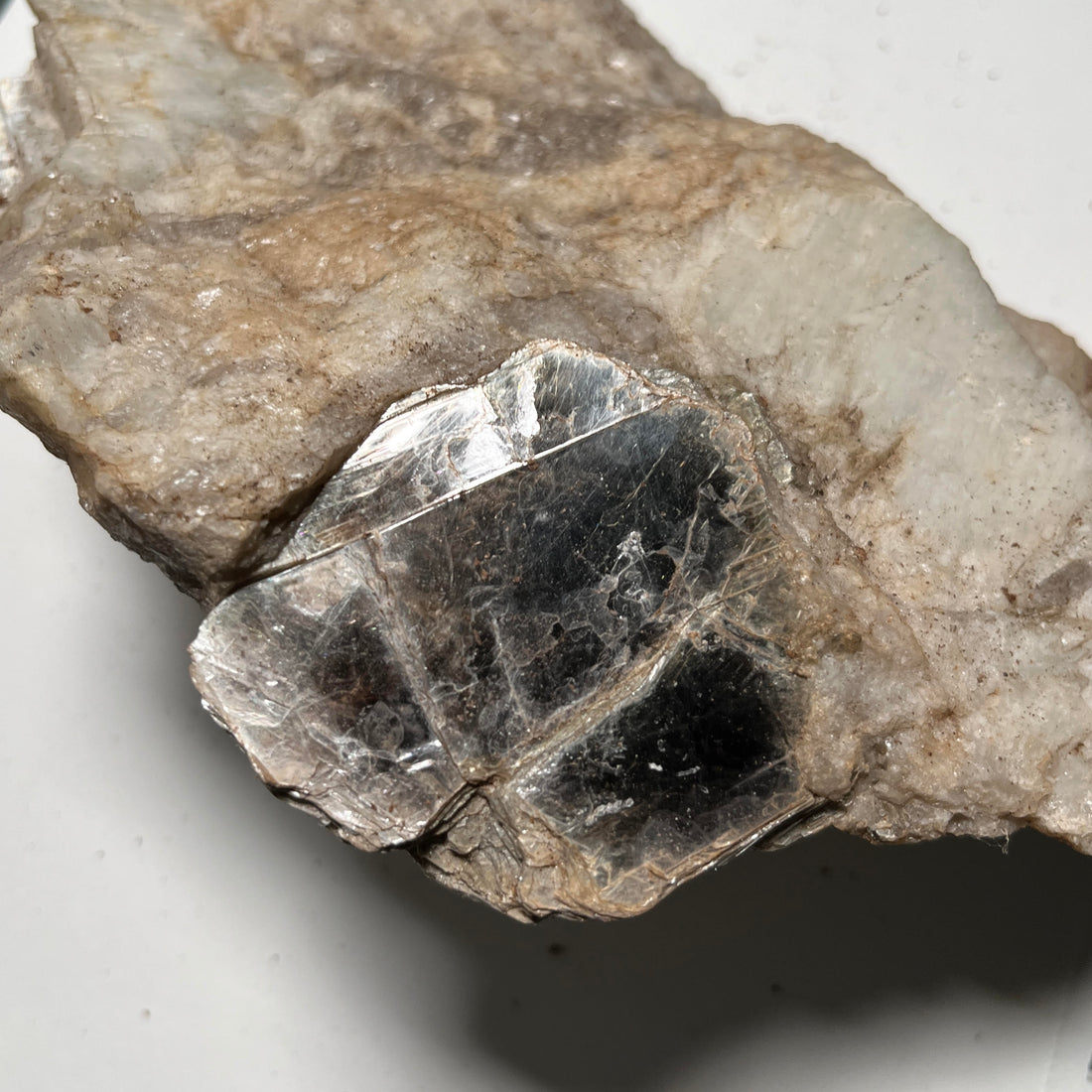What is Muscovite, and what does it mean?
Muscovite is a potassium and aluminum hydrated phyllosilicate mineral (sheet mineral) having the formula KAl2(AlSi3O10)(OH)2; that helps supports equilibrium, clarity, confidence, divine direction, intuition, protection, third eye, and spiritual development. Muscovite is one of the mica family's most prevalent mineral. This blog will help you understand how the science and metaphysical properties are connected.

|
|
||
|
Physical Properties of Muscovite |
||
|
Chemical Classification |
Silicate |
|
|
Color |
Muscovite is colorless when broken into thin sheets, occasionally with a tint of brown, yellow, green, or pink. Thick muscovite samples frequently appear black, brown, or silver in color. |
|
|
Streak |
White |
|
|
Luster |
Vitreous, Silky, Pearly |
|
|
Diaphaneity |
Transparent to translucent |
|
|
Cleavage |
Perfect |
|
|
Mohs Hardness |
2.5 to 3 |
|
|
Specific Gravity |
2.8 to 2.9 |
|
|
Diagnostic Properties |
Cleavage, color, transparency |
|
|
Elements |
KAl2(Si3AlO10)(OH)2 |
|
|
Crystal System |
Monoclinic |
|
|
Uses |
Used in ceramics and electronics. |
|
|
Chakras |
Third Eye & Crown |
|
|
Muscovite Zodiac |
Leo |
|
History:
Sheet mica from the Muscovy Province of Russia for a variety of uses. Muscovy Glass, Cat Silver, and Lapis Specularis (stone mirror), which first appeared in manuscripts as early as the seventeenth century, are some of the first names associated with Muscovite. Johann Gottfried Schmeisser first used the phrase "Muscovy glass," which was widely used at the time, as the stand-alone name "Muscovite" in his System of Mineralogy in 1794. Although Muscovite was referred to as glass, it is not glass. Muscovite has a hardness of two, so it is too soft to scratch glass.
How is muscovite formed?
Muscovite is a common component of medium-grade metamorphic rocks rich in aluminum. It is present in Al-rich schists and helps to create the schistose foliation that is characteristic of these rocks. Although it hasn't been discovered as a component of volcanic rocks, Muscovite is also found in siliceous, Al-rich plutonic igneous rocks (muscovite granites). It frequently coexists in these rocks with alkali feldspar, quartz, Biotite, garnet, andalusite, sillimanite, and kyanite.
Where is Muscovite found?
To find muscovite and any other mineral, you first need to figure out what the geology in your area is. You can download a kmz for your state from the USGS website by following this link https://mrdata.usgs.gov/geology/state/. Once you download the file, you can follow this link to download google earth if you don't already have it installed on your device.
 Muscovite from Ray Mica Mine
Muscovite from Ray Mica Mine
Muscovite can is found in medium-grade metamorphic geologic environments. Atlanta, GA, is located in this geologic setting, so if you're ever in the area, I recommend you visit the Chattahoochee River Recreational area. Several outcrops occur along the park trails, and many of the rocks are garnet schist, meaning they contain garnets and Muscovite. If you visit the bamboo forest, hike to the trail's end, and up the mountain overlooking the river, you'll find a beautiful outcrop of garnet schist. Sope creek is another area where you can discover Muscovite-bearing rocks. Hike across the creek to the Cross creek mill ruins and cross the small creek on the south end of the ruins. This creek drains into sope creek. Once you cross the creek, you'll find several garnet schists lying on the ground. Another place to find larger Muscovite samples is Ray Mica mine in North Carolina. Muscovite is abundant here because this was an old mica mine. This area is located in a national forest, and at night the mountain streams sparkle as the light reflects off the Muscovite. You'll also find aquamarine and kyanite in this location. Basically, muscovite should be in any environment where medium-grade metamorphism has occurred.
How is muscovite identified, and how is it different from Biotite?
Muscovite is easily recognized in hand specimens by its white to occasionally light brownish color and perfect cleavage, which is designated 001 (see figure 2). The 001' cleavage is visible in thin section, and its great birefringence is demonstrated by the stage's dramatic change in relief upon rotation and its 2nd to 4th order interference hues. It is biaxially negative with a 2V between 28 and 50o, transparent, and pleochroism-free, differentiating it from Biotite. The mottled or bird-eye extinction shown by the micas, including Muscovite, is one of the most distinguishing characteristics of these minerals.
Benefits of Muscovite:
Muscovite is a mineral that helps support balance, clarity, confidence, divine direction, intuition, and protection, supports the third eye, and spiritual development.
Emotional Balance:
Muscovite's crystal symmetry supports emotional balance and equilibrium. It's a part of the monoclinic crystal system, meaning its distinguished by a single axis, called an axis of twofold symmetry, about which the crystal can be rotated by 180° without changing its appearance.
Spiritual Growth, Third Eye & Clarity:
Single sheets of Muscovite are clear like a window allowing us to look into our past and future simultaneously; this teaches us to embrace a transcendent view of the past and a confident, clear vision for the future.
Muscovite is commonly formed in metamorphic rocks, which are rocks that have undergone significant transformation from their initial state to form something new. Muscovite metamorphic properties support spiritual growth and the third eye chakra, which helps us to let go of judgments and welcome heavenly inspiration and growth. By becoming aware of your stress triggers, you learn to pick your thoughts and behave honorably and deliberately.
Figure 1: Muscovite (Energy) Atomic Structure:

|
Figure 2: Muscovite Crystallographic Form

Tabular {001}
Locality: Many locations
Lévy, 1837, and others. In: V.M. Goldschmidt, Atlas der Krystallformen, 1913-1923 ('Glimmer').
Confidence, Divine Direction, & Intuition:
Muscovite enhances consciousness and opens the inner vision to improve psychic perception. It softly takes in intuitive knowledge without feeling overloaded by attuning to the higher self. It elevates the mind to evoke deep thinking and easily absorb challenging ideas, increasing confidence in your ability to make decisions. This can be linked to Muscovite's ability to cleave confidently with ease along the 001 planes (Figures 1 & 2). This physical property supports you in being able to execute decisions confidently and with ease. Muscovite has perfect cleavage, and this helps you have the confidence to make perfect decisions in your own life.
Protection:
Muscovite protects your aura from being weathered & eroded by unwanted negative energies and attacks from others. Thanks to its protective powers, your aura is shielded from harmful attachments and psychic attacks. This makes it very advantageous for empaths or highly sensitive persons prone to absorbing tension and negativity from other people. This protective property supports you by helping you easily break free of negative energy. The protective properties of Muscovite can be linked to its various physical properties, such as its mechanical strength, transparency, thermal endurance, weather resistance. Muscovite is regarded as the best type of mica for electronic applications because it's stronger than all of the other mica minerals. Muscovite is moisture resistant and does not swell when wet, thus making muscovite resistant to atmospheric weathering.
Muscovite's ability to shield itself from external energetic forces enables the mineral to support you by shielding your aura from external energetic forces.
Muscovite is a unique stone that will help bring peace and understanding, and it's scientific properties have a connection to it's healing properties. Comment below and tell me how do you feel Muscovite can help you in your life?
If this article has helped you gain a better understanding of muscovite's scientific and metaphysical connection please share it.
References:


22 comments
Worthy
This was great one..
Great
Nice and informative
History is amazing